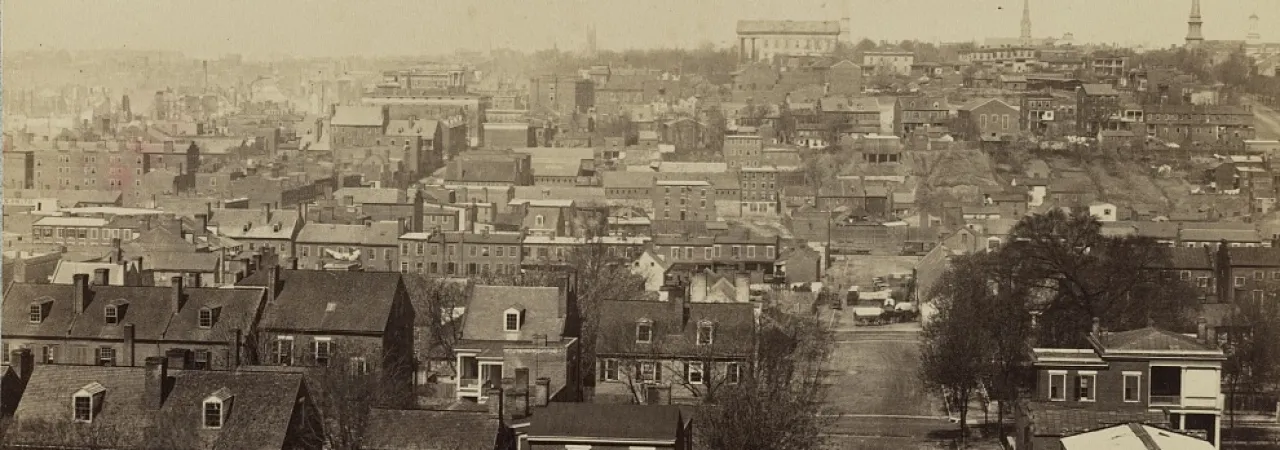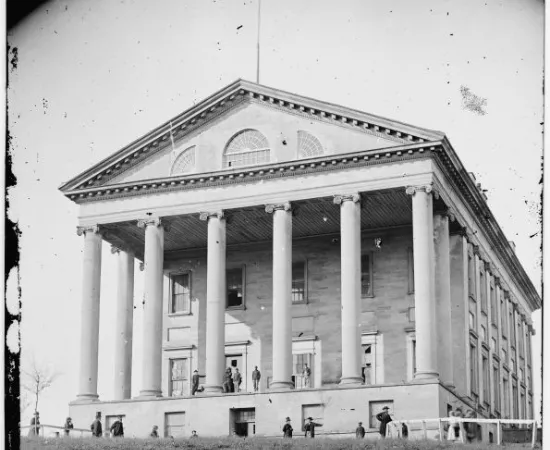
Richmond, Virginia, photographed in April 1865, looking westward.
First Capital: Montgomery, Alabama
Founded in 1819, on the high bluffs above the Alabama River and 330 miles from the Gulf of Mexico, Montgomery, Alabama quickly became the heart of the state's plantation economy. By 1846 Montgomery was named Alabama's capital. In 1861, 9,000 people lived in the city, considered the richest for its size in the nation. Montgomery was a transportation center, with steamboats traveling to Mobile, stagecoaches traveling east, and a railroad running northeast and southwest.
On January 11, 1861, the State of Alabama seceded from the Union. Less than one month later, in early February, the Alabama secession convention invited delegates of the other seceded states to meet in Montgomery to form the new Confederate nation. Delegates from six of the seven seceded states (the Texans arrived late) wrote a constitution for the Confederate States of America in only four days; the next day they elected Jefferson Davis the Confederacy's president. In late February, Jefferson Davis took the oath of office while standing on the portico of the state capitol in Montgomery.
Montgomery's three hotels and numerous boarding houses were crowded with government officials, politicians, soldiers, and newspapermen. It became more of a metropolis than a quiet village, with its streets crowded with carriages and horses, and people on the prowl for gossip, argument, and discussion. Everyone admired the town's beauty.
But by May the summer's humid heat and the mosquitoes changed many people's minds about Montgomery. So when the newly seceded Virginians offered their own state and their own capital as the seat of the Confederacy, many were eager to accept the offer. Mary Boykin Chesnut noted in her diary that her husband, a former U.S. Senator, was against the move. However, she remarked, "I think these uncomfortable hotels will move the Congress. Our statesmen love their ease."
Jefferson Davis was at first opposed, believing the capital should reside in the Deep South, where the feelings for secession were most fervent. However, the Confederate Congress approved the move and adjourned May 21, and scheduled to meet in Richmond two months later. As Dr. James McPherson writes in Battle Cry of Freedom,
"Virginia brought crucial resources to the Confederacy. Her population was the South's largest. Her industrial capacity was nearly as great as that of the seven original Confederate states combined. The Tredegar Iron Works in Richmond was the only plant in the South capable of manufacturing heavy ordnance. Virginia's heritage from the generation of Washington, Jefferson, and Madison gave her immense prestige..."
The Confederacy's Most Permanent Capital: Richmond, Virginia
Davis left Montgomery May 26 at the climax of the fervor following the fall of Fort Sumter and Abraham Lincoln's call for 75,000 troops. Arriving in Richmond, the capital of Virginia, on May 29, he was met by crowds at the railroad station and throngs along the streets to the Spotswood Hotel.

Richmond was a much larger metropolis than Montgomery. The heart of the South's industry, Richmond was also a market town specializing in flour and slaves. It was a beautiful town located at the foot of the Great Falls of the James River and on seven hills. Its citizens compared it to Rome. Between 1861 and 1865, its population swelled to 100,000 and more. Much to its citizens' dismay, many of the new residents were rowdy, noisy, and troublesome. In addition, because the city was the Confederate capital, it became the focus of Union attention. The threat of capture by Federal forces was constant.
Richmond at first thrived as the capital of the Confederacy. Then starved. Then burned when, at last, Robert E. Lee's forces were forced to retreat, leaving the city defenseless.
The Last Capital: Danville, Virginia
Located in south central Virginia, not far from the North Carolina border, Danville was the western terminus of the Richmond and Danville Railroad and a major Confederate supply base. Jefferson Davis and his government traveled to Danville as Richmond fell to the Federal army. The city was the seat of the Confederate government for only eight days, April 3-10, 1865.
Danville's quartermaster, Major William T. Sutherlin, offered his home to Davis and the Confederate government. Davis occupied an upstairs bedroom, and the Confederate cabinet met in the Sutherlin dining room. Davis delivered his final proclamation to the Confederate nation from the home on April 4.
Davis believed that Danville was only a temporary location for the government. He believed that the Confederacy had "entered upon a new phase of the struggle" in which the fight would not be tied to the defense of cities, but taken to the mountains in guerrilla warfare.
But Lee's decimated army could not hold out. The cabinet was sitting at dinner when word of Lee's surrender at Appomattox reached Danville. The Confederate government would have to move immediately. They had originally intended to move to Lynchburg, but with no army operating in Virginia, the government would have to move south, toward Joseph Johnston's army. Davis still had hope the Confederacy could survive the recent series of disasters. He left Danville, Virginia for Greensboro, North Carolina, in the rain.





